May 19, 2016
Trend line analysis can be useful for some things, less useful for others. What we're hoping to see here is evidence for quality play, or maybe justification for the 'eye tests' we make every game. We also looking at how Small Sample Size can really skew numbers. Note that the very last number in the chart is the season number. This will skew the line a bit, but it skews it toward the season-long calculation. This provides a comparison between the trend line and the overall production.
For lack of a better way to organize, I'll present these in alphabetical order.
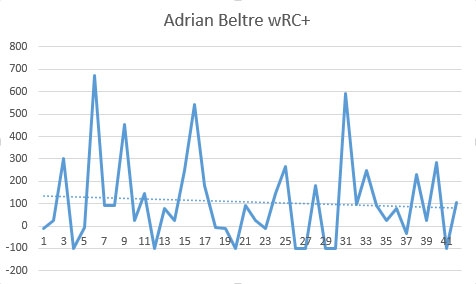
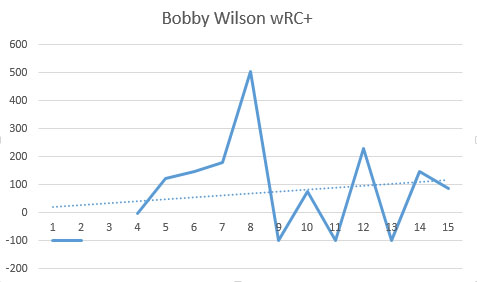
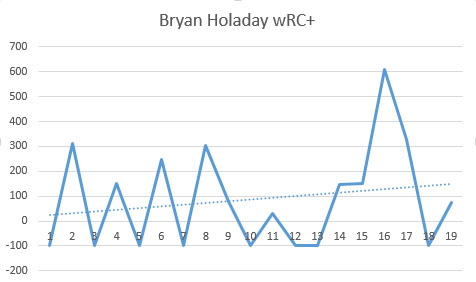
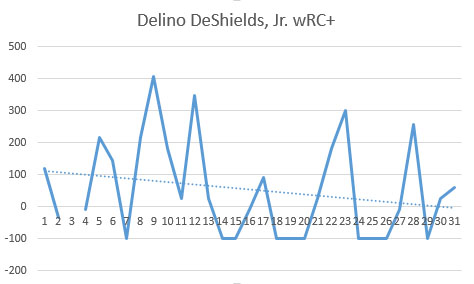
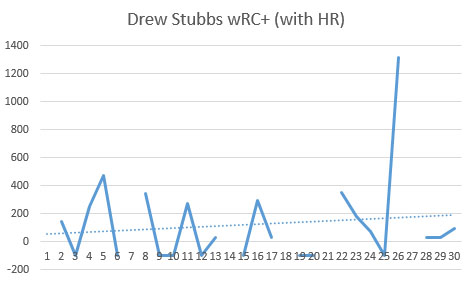
How important are walk-off home runs?

This important. The top chart has "the Home Run". The bottom chart excludes it.
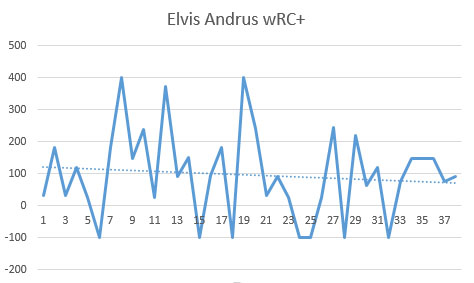
Elvis. I think this confirms the eye test. He's fallen off, but he isn't performing terribly. I wouldn't be surprised if his production stabilizes just under "100". That would probably be "good Elvis".

Wow. Ian Desmond is for real. He is performing consistently, at a high level, and over an extended period of time.
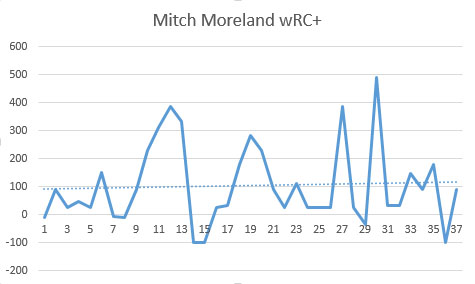

Yes, Nomar is trending down to league average. That's mostly because of the hot start, but he's had more games recently where he isn't being productive with the bat. Fairly consistent with the arrival of a new hitter; there is, as they say, "a book" on him now.
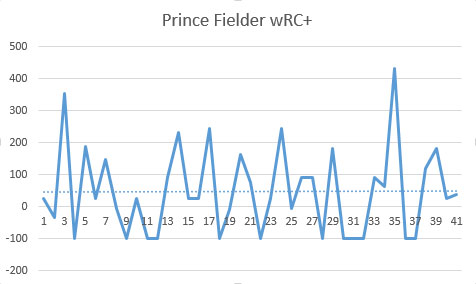
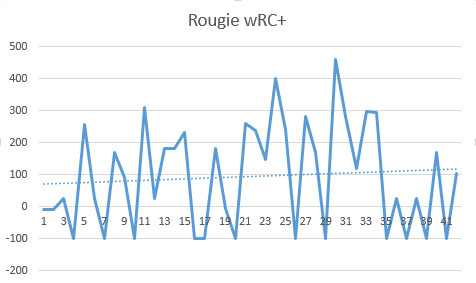

Texas lost one of it's two biggest producers with Rougie's suspension, and Adrian and Elvis are slumping. This is putting the weight of the offense on the rest of the team, which is for the most part producing right around league average. Other than Fielder, the Rangers don't have a lot of "ouch" in the lineup, but they have way to much "meh". Thankfully, the trends behind Rua, Wilson and Holaday are indicating at least the possibility of greater production at the bottom of the order. Mazara stabilizing his minor slide would help a lot, too; he provides the most stable presence at the top of the order while Choo is gone.
Coming soon: we'll look at the rotation and the bullpen.
Posted by: Ben at
05:44 PM
| Comments (4)
| Add Comment
Post contains 693 words, total size 8 kb.
May 13, 2016
If Banister stays true to form, May 13th we'll see some substantive changes in the roster. #ITSJUSTAGUESS
— Ben (@TexasBBTown) April 24, 2016
The Rangers purchased the contract of RHP fireballer Matt Bush. To make room on the 40-man roster Delino DeShields, Jr. has been optioned to AAA Round Rock. Left Fielder Ian Desmond will take over in Center Field, where he's shown better judgement and a better arm than DeShields. Ryan Rua, Texas' 2015 starting Left Fielder who lost most of the year to a broken ankle, will finally get another shot at the job. For the moment, recently signed speedster Drew Stubbs will provide outfield depth and bench speed.
Posted by: Ben at
01:52 PM
| Comments (1)
| Add Comment
Post contains 141 words, total size 1 kb.
April 19, 2016
This... #Rangerspic.twitter.com/XZ9yq1WK5J
— Rob Jackson (@28Jackson) April 20, 2016
Posted by: Ben at
08:34 PM
| Comments (3)
| Add Comment
Post contains 32 words, total size 1 kb.
April 11, 2016
Why GIFs exist. pic.twitter.com/QwwEdZEK82
— MLB GIFS (@MLBGIFs) April 10, 2016
Posted by: Ben at
09:04 AM
| No Comments
| Add Comment
Post contains 18 words, total size 1 kb.
April 09, 2016
This evening, news broke that Shin-soo Choo had strained a calf muscle during batting practice. Uncharacteristically, the club also apparently announced that they were concerned that the injury could actually be something more serious. That's just something you don't do. Take at look at some other breaking news today: Arizona announced that A.J. Pollack's recent season-ending injury actually dated back to the discovery of a broken screw in his surgically-repaired elbow...in Spring Training. At the time (this was following an injury), Arizona publicly announced that there were "no problems" and the club expected A.J. to be back on the field soon. Why THAT happened is a subject for another day, as well; although I did spend some time tweeting about it earlier today.
In discussions on twitter, Rangers fans started immediately asking if Nomar Mazara, one of Texas' Big Four prospects (I still count Jurickson Profar), could be brought up to fill in for Choo. I jumped into a conversation and poo-poo'd the idea:
"My gut says JD waits to pull the trigger on either (Mazara or Gallo) for a long-term change."
I hit ENTER on that tweet, returned to my main twitter feed, and saw this:
Looks like Nomar Mazara is getting the call up to the big leagues. He's been pulled from the round rock game. He's already on the 40 man
— SDI (@ShutdownInning) April 10, 2016
Posted by: Ben at
07:02 PM
| No Comments
| Add Comment
Post contains 358 words, total size 2 kb.
April 02, 2016
This is the time of year to prognosticate which players are going to be *key* to the Texas Rangers' success, and exactly how successful the Rangers will be on the diamond. Jamey Newberg and Ben Rogers discussed, in the debut episode of their new short podcast Spitballin' , that Derek Holland, Martin Perez and Delino Deshields, Jr. were their picks as key players for the Rangers. I agree that two of those players are key, but not, strictly speaking, because the players' individual performances can elevate the team that much. Before we move on, a warning: I don't like making declarative statements that can be easily disagreed with, and I want to stress that this is all based on my opinions.
Deshields, Jr. was a highly rated infield prospect from the time he was drafted until rumors of "lack of effort" ostensibly bumped him off of Top 100 prospects lists. He played rookie ball in 2010, was promoted to A in 2011 and struggled, albeit with 30 stolen bases. Delino repeated A-ball in 2012 and played like an All Star. He was promoted to High-A ball late in the year, where he once again struggled with everything but stolen bases. Deshields started 2013 at Rookie-level again, played himself back to High-A quickly, and again played at a high level with a .317 Batting Average and 51 Stolen Bases. In 2014, with rumors about his effort surfacing, he started at AA Corpus Christi and once again, except for Stolen Bases, struggled to hit. Houston at this point apparently considered him a busted prospect and left him unprotected in the 2015 Rule Five draft, when he was selected by Texas. He was used as a fourth outfielder, something that suited his speed, and was eventually stuck in Center Field when a combination of Deshields' On Base Percentage and Leonys Martin's poor bat and injuries forced a change at the position.
Starting 2016, the Rangers' outfield consists of Shin-soo Choo, Ian Desmond, Delino Deshields, Jr., Ryan Rua, and Justin Ruggiano. Waiting in the wings is, possibly, Josh Hamilton when (if) he returns from the Disabled List.
There are rumors that Ian Desmond may be moving to Center Field at some point this season. He's been making the catches there. While he's certainly not nearly as fast as Delino (not many in MLB are), he has a cannon arm, good throwing accuracy, and possibly a better instinct for outfield fielding than Deshields.
But what about Deshields' On Base Percentage being a "catalyst" for the Rangers last year? Well, I went and looked up what it was. OBP isn't an interpreted stat, it is what it is. Here's how it went:
Me: "Bryce Harper, Joey Votto (duh), Miguel Cabrera, Paul Goldschmidt, Mike Trout, Andrew McCutchen...OK, these are just the best hitters in baseball. These are obvious. Let's get down into the ones you don't think of..."
Me: "Oh, there's Prince Fielder at '10' and Shin-soo Choo at '12'. And they both only had good halves...be really nice if they could both have good years."
Me: "Nick Markakis. Damn. He doesn't do much but get on base. Nelson Cruz...I guess he did more than just hit home runs last year...Kendrys Morales...didn't expect that. Time to turn the page...."
Me: "Dee Gordon? Brandon Belt? Moose? Fowler? Deshields! There he is!"
That's not bad. Deshields was in the top 100 players in On Base Percentage. I had to set minimum plate appearances at 300, which put Deshields at 76 out of 268. That puts him outside of the top 25%, but better than 33%. So, not really *elite*, but certainly *good*. He had the third-best OBP for the Rangers, slotted between Prince and Choo, and Moreland and Beltre.
The problem is that Delino produced at a below-average level offensively, somewhere between his poor minor league years and his good minor league years. Closer to his poor years, but unfortunately in-line with the usual decrease most minor-leaguers make as they advance to higher levels. While his speed is elite and his plate discipline is providing at least part of a good offensive threat, Deshields is out-of-place in Center Field and there's no real reason to expect him to increase his offensive skills.
The bottom line is Delino Deshields, Jr. is an everyday outfielder ONLY on a lesser team, no matter how many kind words he receives for being a "catalyst". With Rua, Ruggiano and likely even Desmond outperforming him offensively, I see Deshields on the bench by the end of May at the latest. Barring players moves and injuries, of course.
To put it bluntly: "Unless Delino Deshields, Jr. is producing offensive value at an increased level, his presence on the bench as a fourth outfielder/speed substitute will be the best indicator that the outfield is healthy and contributing to a winning team."
TO BE PERFECTLY CLEAR: I am NOT saying Delino Deshields, Jr. is a bad player, or has no value to the Rangers. I AM saying he is lacking as a Center Fielder, which can be improved; and he wasn't as significant an offensive threat as he's has been talked up to be, and there's no reason to believe he'll be better this year. Which can be improved, as well. And the fastest way to improve is by using other players who are better than he is.
One week in: Delino batting to the tune of a 85 wRC+ (100 is average), against a 94 last year but in-line with most projections. His OBP is outstanding. There isn't really enough information to judge his defense statistically, but I think all of us have noted his noodle arm costing bases already.
Now let's look at the pitching staff. I have to be forward here; I'm concerned about Texas' starting rotation. I know a lot of Texas fans find this an absurd point-of-view, but I hope you'll stay with me on this.
I'm not worried about Cole Hamels. Hamels is on the bubble of age-related decline, but there an increasing, though inconclusive body of evidence that top-flight, durable pitchers can fight off the effects of aging. Additionally, Hamels had an interesting year in 2015 as he was less effective than he had been, yet managed to work through a move to the American League that necessitated a change in style. Cole finished the year managing to turn decreased peripherals into the kind of performance you expect from your headlining pitcher. Like Darvish, even in bad games he limited damage and maintained control into the sixth or seventh inning, giving the team a good chance to win.
I'm not worried about Martin Perez. His stuff plays; his only liability is a tendency to lose control of his emotions, and therefore lose control of his body. However, before tearing his UCL, Perez was showing that he could maintain composure...I imagine the key is going to be forming a strong relationship with his catcher and with pitching coach Doug Brocail.
I'm not worried about Colby Lewis. Colby has already shown this year that he's going to, barring injury, give Texas another year of the same. He's going to once again define the idea of a #4 pitcher: someone who's reliance on command and fly ball tendencies mean he's going to give up runs and home runs, but he's going to do it in such a reliable and predictable manner that you don't really worry about it at the back end.
I'm not worried about the fifth starter. Which is to say, I'm as worried about the fifth starter as everyone is always worried about the fifth starter. It's the fifth starter. A position that is increasingly just the "spare" starter, rather than a weekly matchup. Have you noticed that? Fewer teams have a named, consistent "fifth starter". It's just "one of the other guys".
Anyway, I bet you figured out who I'm worried about. The only question is, "Why am I so worried about Derek Holland that I listed him as one of the dominoes of the Rangers' season?"
Holland was the 748th pick in the 2006 draft. He performed well in 2007 in Low A and performed even better in 2008 in High A and AA. Notably, he struck out 10 per 9 innings, walked 2 in the same span, and gave up almost 0 home runs. In 33 games with the big club in 2009 he didn't do so well, but still created positive value. Derek went to AAA in 2010, pitched well despite lower strikeout and higher walk rates, and managed to increase his performance slightly when called back to the Rangers. In 2011, he pitched 198 innings for the Rangers and won 16, despite a still-decreasing strikeout rate and a walk rate that was still 3 per 9.
The hope was that now that he had a full season behind him, Holland would begin to add his great peripherals back into the mix in 2012. Except for an almost 50% increase in home runs allowed, he was largely the same pitcher. Fans (and coaches) noted his habit of losing control and frequently giving up his runs in bursts in one inning; sometimes Pitching Coach Maddux and Manager Washington could coax him through the inning, sometimes not.
So once again, hope was put on 2013 for Holland to finally develop completely. And it finally happened, at least to the extent that it probably ever could. Derek pitched over 200 innings, got his K rate back up to 8, kept his walk rate under 3, and cut his home runs allowed by 50%, back to less than 1 per 9. Holland finished the year with a 3.42 ERA, a 3.44 FiP, a 3.68 xFiP, and generated 4.3 fWAR.
THIS was the pitcher Texas had been expecting. Or at least, as I said, close enough to expectations to be completely acceptable. This is a guy you could pencil in to that #2 slot that "Hollywood" Cole go-sit-down-now-kyle-seager Hamels will occupy in a rotation headed by Yu Darvish.
And then it all came crashing down. Again. Literally.
Before the season started in 2014, Derek fell down some stairs and micro-fractured something that you can't pitch if it's micro-fractured.
BUT...when he came back from rehab and conditioning, right at the end of the season, he pitched in 6 games, winning 2 and ending with 1.46 ERA and...2.19 FiP, and 3.72 xFiP, so there was a lot of luck involved...and his lowest K rate ever except for 9 official innings at Round Rock in 2012...but his walk rate was good, and he allowed no home runs.
What to make of this? The peripherals are a mess, which, honestly, you should probably expect of someone who almost lost an entire year of baseball.
So...2015...Derek Holland tears up his shoulder in his first game of the year. He comes back after the All Star Break and pitches in 10 games. His K rate is still around 6 per 9, his walk rate is still around 2.5 per 9, his home run rate is back up to 1.5 per 9; he pitches to a 4.91 ERA, a 5.30 FiP, but also a 4.45 xFiP...so that's....not very good, but should have been better.
Projections all say he'll be about as good as Colby Lewis has been going forward (they all say Colby Lewis won't be as good as he has been going forward). And *that's* only if Holland is healthy enough...his projected value is based almost entirely on his ability to take the ball for 150+ innings.
In other words, Derek Holland, as befitting all evidence, is likely to be the third fifth starter, slotting between Colby Lewis and whoever the other guy is.
So, to start the year off, Texas will have a solid TORP, Cole Hamels, followed by Martin Perez, who should be a solid MOTR starter, with probably enough upside to look like that farm-developed #2 pitcher Texas has been desperately seeking for years. The guy Derek Holland was supposed to be. After that Texas will throw out Colby Lewis, who will probably have a few games this year where he flirts with shutouts and complete game wins, and quite a few more where you'll be glad he made it through five giving up a run per inning. But he won't actually blow up very much, and those few gems he pitches make it all worthwhile. A #4 starter with ton of "grit." And then you've got the guy I've decided to call Russel Stover this year. You know Russel Stover. The "box of chocolates" company.
Except, honestly, we know what we're gonna get. Probably. Derek Holland is the last man in the rotation who is guaranteed a spot if he's healthy. He's not getting traded, not now. Unless...nevermind. If he pitches well, his option next year is so cheap it's a no-brainer to pick up. If he pitches poorly, then he's your default #5.
That's why Derek Holland is my pick for the other key "domino" player. Because if I'm right, there's a huge hole in the middle of the rotation right now, and we better all hope Yu is in good form when he comes back from Round Rock or Frisco in six to eight weeks. Yu/Cole/Perez/Lewis/Holland isn't perfection, but it's pretty darned good.
If Holland "regresses" back up, to a form he hasn't had for a few years, then everything is fine. If he really is the worst pitcher in the rotation...then that sets the dominoes in motion, because a World Series hopeful needs another pitcher up there in the 1 - 3 slots...not another pitcher than can fill in the #5 slot. Those guys are cheap.
After the first week: Cole Hamels had a great start, except for Home Runs. I doubt that's a long-term problem. His peripheral stats indicate that, except for the home runs, he pitched wonderfully. I know a lot of people are going to read this and say "no duh", but I would like to stress that the statistical measurements basically say that Cole made a handful of bad pitches, and all the rest of them were very, very good. Not worried
Martin Perez: walks. We knew this. Attack the zone. Also, did you watch the umpiring in that game? I'm not sure how much I'm going to put on Martin.
Colby Lewis: Below average for Colby, but not by much. It's OK. He beat his xFiP.
Derek Holland: He pitched in-line with projections. Statistically, he was on par with Lewis.
A.J. Griffin: Texas has one pitcher who has produced positive value by fWAR. It's Griffin. But don't get too excited...while his ERA and FiP were in-line, walking twice as many people as you strike out leads to an xFiP of "STINKY". Now, Texas has spent a fair bit of time fielding pitchers who get outs via the ground ball almost exclusively, so it's possible Texas can make this work. Anyway, congratulations to A.J. Griffin, the Rangers' best starting pitcher in the first week!?!
Posted by: Ben at
11:01 PM
| Comments (3)
| Add Comment
Post contains 2564 words, total size 16 kb.
March 15, 2016
It has, specifically, a "Josh Hamilton" problem. We'll call it "The Josh Hamilton Problem".
If you're a Rangers fan, you know what a "Josh Hamilton" problem, a.k.a. a "Josh problem" is. Richard Durrett wrote an article about it for ESPN in 2012. Here are some Josh Hamilton problems:
"Ocular Keratitis" kept him out of the lineup for a week in 2012. That's when downing too much caffeine dries your corneas out.
Josh had a period in which he couldn't hit during day games. The problem was his baby blue eyes reflecting light the wrong way. He tried sunglasses and eye drops. No word on what finally solved the problem.
He quit chewing tobacco at one point, causing a slump. Even when he broke and strained things out of pure hard effort (like Rangers great Rusty Greer, Hamilton is no stranger to the outfield wall), he usually broke or strained the WRONG something.
Early in 2015, Josh was traded, two years through a five-year-$125 million deal, from Los Angeles back to the Texas Rangers. While the specific details have never actually been released, front office leaks and certain public details have confirmed that Los Angeles is paying practically ALL of Josh's contract through the final year; 2017.
Free Left Fielder. Former MVP. Freakish natural talent. Slightly used and abused. Mostly by himself...but still.
There was no small amount of grousing about this trade. It had been clear from the start of his time in Anaheim that Jon Daniels' refusal to hand over buckets of money to Hamilton was prescient. In 2013 Josh produced at half the level he had in 2012. In 2014, he was about 50% worse again (we're talking overall value here, by the way). He ended 2014 hurt, and while recovering he relapsed with cocaine and alcohol. That's how he ended up back in Texas.
The Hamilton acquisition for Left Field displaced some potentially promising talent, and seemed to guarantee a position for someone who wasn't actually perceived to be either reliable or even all that good anymore. Yet when he returned to the field, after many dazzling smiles and a muddled apology for hurtful words, he was met with cheers. So many cheers.
Certainly he was still Josh Hamilton, but he was home. He was OUR Josh Hamilton.
And he mostly performed to expectations. Josh was hurt when he got here, hurt at the end of the season, and hurt twice during the season. Josh appeared in 50 games, and batted .253/.291/.441. Bizarrely, his ISO was the highest it had been since 2012, .188. He hit 8 home runs in his fifty games. Two or three of them took the lead or won the game directly.
At the end of 2015, Josh hurt his knee. He had it operated on, hurt it again, had it operated on AGAIN, but it still hurts. The most recent news is that there really isn't anything that can be done at this point. Josh is trying some alternative treatments, but he acknowledges that the knee is what it is. It's going to hurt, he just has to figure out if he can manage the pain.
Dare we think it, if he can still play.
So now the Texas Rangers have a Josh Hamilton Problem. The Josh Hamilton Problem is that he's here, on the Rangers 25-man roster. And he will be all this year and next, barring stays on the 60-Day Disabled List. What do you do with Josh Hamilton?
Let's ask some questions.
Can Josh Hamilton still play baseball at the Major League level?
OK, we have to break this one down.
Can Josh Hamilton play Left Field anymore?
If his knee is what he says it is, that's probably a really bad idea. Let's go with "no". You could still project Hamilton to be a platoon Left Fielder right up to the point that he said the knee can't actually be fixed, he just has to learn to live with it. Even now, a day or two after I started writing this, Josh has informed the media that he's "pain free" and will hit the field this week. But he was "pain free" only a few weeks ago, before tweaking the knee again so badly that he was on crutches. There has been no structural repair of any kind since then, only rest and some non-traditional stem cell and plasma treatments. Maybe he could still be a platoon Left Fielder, but Texas has already said they like the idea of a three-man bench to start the year. And even when Josh is back, supposedly by May, is a spare left-handed bat limited to Left Field defensively the best use of your bench slot? Still, here's an optimistic tick-mark: IF Josh Hamilton can manage his knee, and IF Ian Desmond (who isn't going anywhere for a while) can cover Center Field, then Josh is your fourth outfielder. Keep in mind, I'm not saying this is the BEST use of resources, just a plausible one.
Normally, when a guy has bum knees he doesn't play the field. But for sanity's sake we'll assume he can learn to run on the bum knee; so he's a Designated Hitter. And now we have a Stack Overflow, because the DH buffer is full. Prince Fielder is the primary DH and backup First Baseman, Mitch Moreland will be in the lineup if he's hitting, and Adrian Beltre will need more At Bats at DH any minute now. And then one of the bench bats will probably be another right-handed bat to substitute for one of the left-handers, which Texas has several of. So the only reason you need Josh Hamilton as a DH is if there's reason to believe he's going to be much better than any of these other options. Or if you trade Prince Fielder.
So, DH and.........
Oops. We just used up Josh's only remaining natural position. However, even if it's just for fun, keep track of the two big IFs. IF Josh Hamilton can only DH, and IF Prince Fielder gets traded, then you can use Hamilton as your full-time DH. The biggest thing this would accomplish would be the salary dump, honestly; Josh isn't likely to be as good as Fielder was last year...but Fielder could decline, which you really don't want because what you're after is to dump as much of his salary as you can...and Hamilton could improve which could actually make him more valuable than Fielder...
HEADACHE.
So we'll tick-mark that: If Fielder gets traded, the Rangers MIGHT have a roster spot for Hamilton.
Josh Hamilton being on the roster for the purpose of playing a position for the Rangers comprises two big IFS no matter what and a whole lotta HEADACHE figuring out how to do it.
Let's move on to managing the pipeline of talent.
Here's a list of the players that could also fill Josh's roster spot:
Ryan Rua - 4C Right-handed bat.
Justin Ruggiano - All 3 OF positions and 3B Right-handed bat.
Do you want Hamilton blocking these guys? Sure, some of them won't actually be in Arlington this year; but Hamilton has another year on his contract.
So we could make the argument that, barring player moves and subject to injuries, the only reason to keep Hamilton on the roster is because he's under contract. And that's not WEIRD, but it sure complicates things.
Clearly the best thing to do would be to just release Hamilton.
But that's a problem, too.
.........
In the 2012-2013 off-season, General Manager Jon Daniels traded fan-favorite, team-leader, former-middle-infielder/utility-infielder/DH Michael Young to the Philadelphia Phillies. At the beginning of 2012 Young was coming off of his best year since 2006, although it wasn't much of an outlier against his recent production. In 2012, however, Young was brutal. His steadily-declining defense was even worse, and his saving-grace bat suffered dramatically. Additionally, there was some standing "bad blood" between Young and Daniels; as Young was increasingly frustrated with the Rangers moving younger players into his position and asking him to move. There was also perceived to be pressure from the front office to bench Young in favor of other players even in the Utility role.
Despite the poor performance, the actual trade of Young was a shockwave through the fanbase. While the move could be defended statistically, fans had trouble believing that Texas had actually traded away Michael Young. Sensible, or not, the trade brought wide-spread condemnation on Daniels and Rangers ownership. When Young returned to the Rangers a year later to retire, Jon Daniels said the trade had been a mistake; a move he wouldn't make if he had it to do over again. He cited clubhouse chemistry and Young's leadership of the team as qualities that he though would be easier to make up for than they were.
Josh is a polarizing player. Booed on his way out of Arlington, cheered on his return. One Angels blogger was so happy to see him leave L.A. that he gleefully wrote a highly-personal, profanity-laced attack on Hamilton that got him banned from the website. HE WAS THAT HAPPY TO SEE HAMILTON LEAVE. There are Rangers fans right now that would be tempted to do the same if Hamilton were traded. Or released.
And "right now" would probably be the time to do it. Hamilton is hurt. Again. He never got to hit a homerun in spring training for fans and the sports press to fawn over, that would make it a bit confusing for more casual fans to grasp why Hamilton was gone. No one is thinking about him "right now". He's just another Ranger headed for the Disabled List.
But there are problems, even if a decent plurality of Ranger fandom may not see it that way.
What happens if Josh Hamilton is traded?
Jon Daniels: "Hey, we've got this guy whose only real home is in Arlington but we can't have him clogging up our 25-man roster. He's free but under contract this year and next, and if you're lucky he can DH 80 - 120 games. Extreme power hitter, but falls off to left-handed-platoon-designated-hitter-levels if he's not 100% in balance. Which is most of the time."
GM on the other end of the line: ".................." CLICK. CALL ENDED.
Just to be safe, we'll say it this way: For all intents and purposes, Josh Hamilton can not be traded.
Would Texas fans be as upset about Josh going away as they were about Michael Young, or Ian Kinsler, or (most appropriately) Mike Napoli? Probably not. Even the most casual fans know Josh is hurt and broken. But that's the crux of the Josh Hamilton problem.
Baseball is made of stories, almost as much as stats. A lot of you will say it's the other way around, by a large margin, and that's fine. I don't begrudge that opinion. Josh Hamilton has a story. Constantly recovering addict, fallen and redeemed Christian, one of the biggest hambones out there. He's a goofy, bone-headed doof one minute, and some semblance of one of the most amazingly gifted baseball players ever the next.
The Texas Rangers have many stories. I'm not going to give examples, but the one we're interested in is this: Texas is developing a reputation as a club that will work with recovering addicts and players needing special physical or mental recovery regimens. They will seek out support, they will accommodate special needs, they will construct an environment tailored for the recovering addict/baseball player to have a chance to get well and thrive. The Rangers have done it with Hamilton twice, there are some very quiet rumblings that they tried to do it with Tommy Hanson, who wasn't willing to work within the Rangers rules (to be 100% clear: this is a RUMOR, it just makes a bit of sense), and they are now doing it with Matt Bush, the former-top prospect infielder-now-relief pitcher who just got out of prison for a DUI hit-and-run.
What happens to that story if Texas cuts Hamilton tomorrow? Not because he relapsed (strike three, Josh!) but because they need the roster space?
"Sorry about that addiction stuff and the personal problems, but we both knew what this was from the beginning...despite all the talk about helping an old friend and bringing you home and..."
Yeah. PR nightmare.
And before you start; yes, I know a lot of you are saying "Who ******** cares about the story? He's just taking up space!"
I get it. I respect that opinion. It's valid. We're in baseball to win, not for group therapy. It just so happens that baseball *is* therapy for a lot of people. And a lot of fans *like* the stories as much as winning.
My point is that no matter what you, the person who disagrees thinks, to a lot of fans cutting Hamilton would be like kicking a puppy with a broken leg because it can't get out of the way fast enough.
If you're the General Manager of the Texas Rangers, you don't want to get caught on video kicking a puppy with a broken leg.
And that...is why the Texas Rangers have a "Josh Hamilton Problem."
He can't play.
He can't stay.
He can't go.
"Guys, it’s me, it’s Josh – it’s going to be something weird."
Posted by: Ben at
06:58 PM
| No Comments
| Add Comment
Post contains 2545 words, total size 17 kb.
March 09, 2016
Would you give him $60 million for a three year extension?
If you based your decision ONLY on the information I shared, you would probably come to the conclusion that it's probably a good deal. You're paying for two years of production over three years, something a guy like this will almost certainly reach.
On the other hand, if you're reading this *here* (a Rangers blog), then you know who I'm talking about, and you know I'm leaving out a REALLY IMPORTANT piece of information.
The player is Adrian Beltre, and the contract extension would cover his ages 38 - 40 years.
Now, of course, if you don't know who Adrian Beltre is, and all you're understanding here is "AGES 38 - 40", then you're thinking "Are you insane?" If you know who Adrian Beltre is, then you're thinking "Hm. Umm. Welllllll....huh. I don't know...I mean this IS Beltre...but that's a lot of money for a guy in his late 30's who's going to start declining ANY MINUTE NOW...right?"
But I want Adrian Beltre on this team. His best run as a player has been with the Rangers, and he's a no-doubt Hall of Famer. Now, I don't give a damn about the Hall of Fame....except when I do, and for some stupid reason I want Adrian Beltre to go in with a Texas Rangers cap, and I want his biography to say he cemented his HOF credentials by being the best Third Baseman in the game while he was with the team.
Do you pay for that? If you do, how much?
I mean, it's not like he's going to be sitting on the bench with Josh the next few years. Beltre ended last year playing most of the year with a TORN LIGAMENT in his thumb, the same ligament tear that has taken two prominent players out of the game for months recently, and he was STILL one of the best players in baseball in the second half.
If we were talking about a 32- or 33-year old, it would be a no-brainer. At current rates, Beltre has to average a little over 2 1/2 fWAR per year over three years. Dude was worth over 4 1/2 last year WHEN HE WAS HURT.
38, man...I don't know.
Posted by: Ben at
10:59 PM
| No Comments
| Add Comment
Post contains 617 words, total size 4 kb.
March 08, 2016
I tweeted back and forth with Jared Sandler (Rangers contributor for WFAA and other places) on this issue yesterday evening. In and of itself, I don't think the Ian Desmond deal was the *right* deal, but it was certainly a *good deal*. The one area where it really bothers me is that it blocks Rua, who the Rangers considered major league left field talent before he broke his ankle. He's showing once again that he's a legitimate LF option, but with Desmond on a one-year MLB deal, Rua gets pushed further down the depth chart. Ruggiano will almost certainly get playing time before Rua does, and I would bet after Rua's poor play coming back from injury Texas will likely be inclined to play him in Round Rock for a while.
So, playing odd-man-out, which is where Sandler seemed to get edgy: if Rua mashes, who does he knock out of their current gig? Desmond isn't going anywhere; he's on a MLB deal so it's DL, trade, or release if he's a bench bat. Ruggiano can play all three outfield positions and potentially 1B; he has the historic stats to suggest he *is* the right-handed platoon bat anyone would want. Choo isn't going anywhere, especially if he plays to his potential. That leaves DDJ, and on the face of it he's the most likely to lose his position as this point. Ruggiano can play center and may have as a good a bat; unless Desmond bombs he's still in LF, and if he bounces back even a little he'll probably hit better than DDJ. That moves DDJ to the bench, and he's faster than Rua so he keeps the fourth outfielder spot. Rua is still in AAA.
Added info: Evan Grant's lineup update for March 8th presents a breakdown of outfield options. He implies (does not directly state) that Ruggiano likely became the odd man with the Ian Desmond signing. That is, Ruggiano was signed to platoon with Hamilton, but supposedly Ian Desmond will now hold down left field until someone pushes him off. Plus, Rua has options, Ruggiano doesn't. The job he was signed for his gone, and his guarantee is only $500,000. He may be done in a few weeks.
My conclusion: it will take two player moves/transactions in the outfield to occur before Rua gets called up. Which is a real shame, because I think the ability to be a full time Major League outfielder is there. And once again I say "getting Ian Desmond for 1/$8 was a fantastic deal. I'm just not sure it was the right or best deal for Texas."
Posted by: Ben at
09:49 AM
| Comments (1)
| Add Comment
Post contains 512 words, total size 3 kb.
March 07, 2016
For those who don't remember, Chase Utley broke Ruben Tejeda's leg on a takeout slide into Second Base during Game 2 of the 2015 NLDS. Utley was the recipient of extensive criticism for deviating significantly from the basepath on the slide, in an obvious effort to try to physically hinder Tejeda, who was trying to turn a double-play. While Chase Utley is well-known for pushing the boundaries on this particular play, his play was also defended by many players. To sum up, even those critical of Utley specifically defended the use of "takeout" slides on double-plays as an integral part of the game.
Chase Utley received a two game suspension from MLB for the play, citing his deviance from the basepath as being excessive, and therefore judging his slide as an attempt to harm another player. Utley appealed the decision, allowing him to complete the series at least before a judgement was made. When the Mets defeated the Dodgers, the appeal was put off until the off-season, with the suspension intended to be carried out during the first two games of the 2016 season.
Once the season was over, MLB was encouraged from all corners of Major League Baseball to review the rule governing Second Base slides before the 2016 season began. This was done, and changes to the rule clarified that intentional takeout slides would no longer be allowed, but efforts to hinder the fielder during the course of a normal slide would generally be allowed, although there is room for Umpire discretion as well.
As an addendum, Chase Utley's suspension will, according to some sources, be dismissed.
There's a lot of consternation about this move, if true. However, considering the adoption of the new "clarifying" rule about second base slides, this almost had to happen. The new rule is a tacit admission that the old rule wasn't clear enough. And considering you can't redo the playoffs, it's also largely meaningless.
Of course, you can argue that Utley was obviously engaging in a dangerous slide that violated the intention and the spirit of the rule by too large a margin. However, players argued that the rule wasn't 100% clear, and many players interpreted the rule differently. Changing the rule at this point functions as MLB agreeing the rule wasn't clear enough...if the rule wasn't clear enough, then you can't "prove" Utley violated it.
There is a certain amount of legalism in this argument, I admit. A large percentage of fans, and even baseball professionals, criticized Utley's slide as being well beyond what they considered accepted norms. But once again, we turn to the wide disagreement by fans and players on this issue that was prevalent at the time, showing that there really was no consensus on the rule. Beyond that, even if there had been wide agreement, the only opinions that would actually matter are the Umpires' consensus understanding of the rule, MLB's official interpretation, and the Player Union's collaborating opinion.
Put simply, the act of changing the rule to make it clearly reflect what Utley was suspended for is itself an indicator that the rule *did not* already describe the criteria for breaking the rule. If the rule could not clearly be demonstrated to be broken by Utley, he can't be suspended.
Those changes likely don't affect the Rangers, much; only Rougned Odor has any kind of reputation for that level of "hard play", but I haven't seen him make the kind of move that Utley was known for. The rule doesn't address going into a legitimate slide "spikes up", as some people call it. It remains to be seen if the Umpires will apply the "intention" of the slide change to other areas of aggressive baserunning. Something that *will* affect Texas is the practical elimination of "the neighborhood play".
The Neighborhood Play is an overly-elaborate description for the act of the fielder manning Second Base turning a double play while not actually being in contact with the base or even having tagged up. Umpires and players have worked under the assumptions that A) Any clean catch and throw at second would beat the runner from First whether the Second Baseman or Shortstop were tagging up or not, and B) Because of takeout slides, the fielder at Second was safer standing away from the base.
In order to show how strictly they intend takeout slides to be governed, MLB has also empowered Umpires to use strict guidelines to judge Second Base tagging by the fielder. "Neighborhood Plays" have also been made reviewable. This is saying as much via intentions as with actual wording...something that has admittedly been the bane of baseball as often as it has been a boon.
The intention is for runners to slide *before* reaching base and the runner *must* make contact with the ground *before* reaching base. The runner must target the base with their slide, and cannot attempt to alter the slide away from the base after starting the slide. As a compensatory move to support the runner, the fielder at Second must now cleanly tag the base while in possession of the ball before throwing it on in an attempt to get another out.
I haven't seen enough of Odor to judge whether this will be a problem for him, but I do worry about Andrus. Elvis is widely reported to have issues maintaining focus and intensity, but acts instinctively when he's on his game. I will not be surprised to see Elvis miss double-plays this year because he never tagged up.
Posted by: Ben at
10:14 AM
| No Comments
| Add Comment
Post contains 944 words, total size 6 kb.
February 28, 2016
Adam Morris at LoneStarBall thinks Desmond is actually being signed as the full-time Super Utility guy...someone who can fill in for outfielders and infielders alike, thus clearing the bench of at least one extra player.
Maybe. That makes more sense than signing him to be a Left Fielder.
I think (hope) that this was done because the Rangers have a big trade locked down already. If so, there hasn't been word one about it.
On the face of it, this just doesn't make a lot of sense. Texas has been quoted over and over again saying, "we can't go after a better defensive center fielder like Fowler or Jackson because money. We can't spend even $8 million a year." Well, that was bullshit. They have been quoted over and over saying "we're going to platoon in Left Field. That's why we keep signing platoon-friendly outfielders like Justin Ruggiano and Drew Stubbs." That was a bunch of baloney, too.
I don't get it.
Posted by: Ben at
01:01 PM
| Comments (1)
| Add Comment
Post contains 171 words, total size 1 kb.
February 27, 2016
"He's annoying. He won't shut up, he talks all day...I want to kill him." - Beltre on Andrus during Sportscenter (h/t @Travis5mith )
— SDI (@ShutdownInning) February 27, 2016
Posted by: Ben at
04:23 PM
| No Comments
| Add Comment
Post contains 35 words, total size 1 kb.
February 12, 2016
BASERBALLER$ - Best Friends Adrian Beltre and Elvis Andrus
Posted by: Ben at
12:51 PM
| No Comments
| Add Comment
Post contains 27 words, total size 1 kb.
January 21, 2016
Mitch Moreland and Colby Lewis ready to go. Lewis has dropped 25 pounds cycling. pic.twitter.com/omjqImHiiK
— Anthony Andro (@aandro) January 22, 2016
One should note that Pablo Sandoval is a 5'11" third baseman "listed" at 245 lbs. and Colby Lewis is a 6'4" pitcher "listed" at 240 lbs. In 2015, Pablo was probably closer to 325 and Lewis was probably around 275.
Posted by: Ben at
07:19 PM
| No Comments
| Add Comment
Post contains 102 words, total size 1 kb.
January 16, 2016
I wouldn't think, at this point, Davis would have had too much trouble getting more...so I wonder how much impact his spotty batting history had on teams' assessment of his value. He surely had two great years in the past three, but his big league story outside of those two years is largely one of failure. There has to still be some question concerning what happens if he loses his grip on his particular batting mechanics that have finally allowed him to succeed in Baltimore. As happened in 2014, when he turned in a dismal half-season before returning to acceptable levels.
There's also a minor question regarding drug use...he's been on the periphery of steroid and HGH allegations before, and was popped for amphetamine use in late 2014. Drug-use rumors of any kind haven't dampened teams' analysis of other players, though; so I doubt that had much impact.
Anyway, congratulations to Chris, the last of a long line of 1B that the Rangers never could figure out and traded away.
Posted by: Ben at
09:31 AM
| No Comments
| Add Comment
Post contains 286 words, total size 2 kb.
43 queries taking 0.068 seconds, 133 records returned.
Powered by Minx 1.1.6c-pink.









